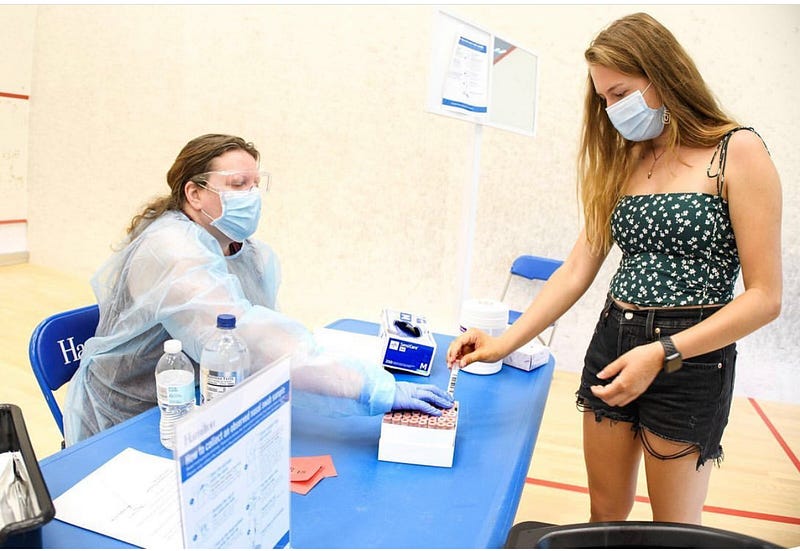
Hamilton’s approach to COVID-19 testing is relatively rigorous in comparison to other institutions in the Upstate New York area, and with this approach, the college has had success so far. With over 10,000 student tests and over 3,000 employee tests conducted and counting, Hamilton still maintains a zero percent positive rate of COVID-19 cases. While other colleges and universities are doubling down on restrictions and even closing their campuses, Hamilton proceeds with the academic year, largely due to these exhaustive testing procedures.
Hamilton’s COVID-19 Task Force determined the testing policy during the summer in accordance with guidelines from the CDC, NYSDOH, ACHA, and other organizations. Terry Martinez, Vice President and Dean of Students, explained the decision process saying, “We spent all summer planning for student arrival, speaking with experts at Harvard, Johns Hopkins University, and others to keep abreast of the science and to learn about how to best mitigate and contain a spread.”
Before returning to campus, Hamilton required students to complete a diagnostic molecular (PCR) test one week before their individual arrival dates. Barb Fluty, Director of Student Health Services, believes that “our pre-arrival testing approach benefited us, coupled with a thorough testing plan for the semester and campus awareness/vigilance.”
Once on campus, students were immediately tested before receiving their move-in packets. Students then quarantined in their campus housing until their tests came back negative. No students tested positive, so there was no need for additional isolation, quarantine, or contact tracing to take place following move in.
Hamilton is partnered with Bassett Healthcare Network to facilitate on-campus, self-administered tests. Students and employees can schedule tests via an electronic reservation system. The testing center is open Monday through Friday, 8:45 a.m.-12:30 p.m. and 1:30 p.m.-5:15 p.m. The tests are then processed by the Broad Institution located in Cambridge, Massachusetts, and the results are typically received within two days.
Students are required to get tested twice a week, with a minimum of 48 hours between tests. The ideal testing schedule is either Monday/Thursday or Tuesday/Friday. Employees in contact with students are also tested twice a week, and all other campus employees are tested once a week.
Another factor attributing to Hamilton’s success is the low positive testing rate in the surrounding area. Director Fluty stated
,
“This benefits the community as a whole. We hope this will continue in order to keep SARS-CoV-2 manageable for this entire region.” According to the Oneida County COVID-19 Dashboard, of the 120,636 tests administered, only 2,305 have been positive, as of September 9th.
In the event that there are positive cases, Hamilton has a thorough plan to mitigate risk. As Director Fluty explained: “When there are positive cases, we will work in coordination with Oneida County Health Department personnel towards rapid notification, contact tracing, and containment of both positive and exposed individuals in order to limit additional exposures.”
Students who test positive will be isolated in a Bristol room with a private bathroom until they are cleared by the local Health Department. A contact tracer will determine if there are any individuals who may be at risk as a result of close contact with the infected individual per CDC and County Health Department guidelines. These students would be transported and housed in a nearby hotel to quarantine for two weeks. These procedures are in place in order to hopefully break the transmission cycle and limit the number of positive cases on campus.
In comparison to peer institutions, Hamilton is performing remarkably well. Out of the eleven NESCAC schools, Hamilton is the only one with zero positive COVID-19 cases. Dean Martinez is “proud of the results of our aggressive testing. The results have proven beneficial to our community.”
An article titled “Small Colleges Try to Contain COVID Clusters” published by
Inside Higher Ed
on September 8th discusses how small colleges are combatting COVID-19 in comparison to larger institutions. Most COVID-19 modeling studies are based on large, urban institutions. The article focuses on information from Nicole Eikmeier, an assistant professor of computer science at Grinnell College, who published a paper modeling the spread of COVID-19 at small residential colleges.
Professor Eikmeier established that the two most effective intervention methods are wearing face-masks and regular COVID-19 testing. According to Eikmeier’s study, “At a minimum, colleges should test at least 25 percent of the student body every week…Without testing at or above this level, our results suggest that it will be hard to control COVID-19 spread.”
Hamilton is performing above and beyond this minimum by testing all students twice a week, and the student body is successfully wearing face-masks. The study additionally noted that smaller liberal arts colleges have a better chance of limiting the spread of the virus because they can be self-contained and limit their contact with the outside world.
Ms. Fluty made the following statement regarding the campus community’s response and actions going forward:
“I want to thank all community members for their willingness to use the Emocha app daily and participate in on-campus testing efforts regularly. I applaud everyone choosing to follow the guidelines that have been established to limit the spread of SARS-CoV-2: wearing masks, physical distancing, frequent & thorough hand washing/cleansing routines, and avoiding large gatherings. I know that it is not always easy but it works. Finally, just because you test negative this does not mean you can become complacent or let your guard down. Mitigation efforts need to be continued until an effective SARS-CoV-2 vaccination is developed and distributed.”
Ultimately, no matter how many tests are administered, the rate of COVID-19 spread is heavily influenced by campus culture and mutual accountability among students, which involves wearing masks, following social distancing guidelines, and abiding by the agreement to get regularly tested.
















